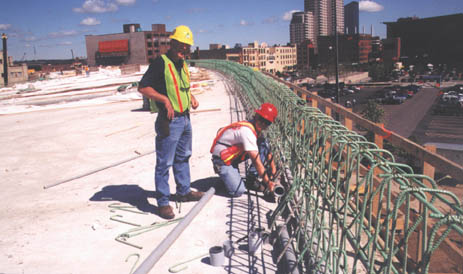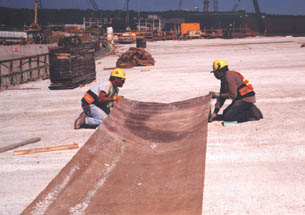Trades straighten U.S. 131 S-Curve
Date Posted: July 21 2000
GRAND RAPIDS - The building trades and Kiewit Western Co. are working hard to improve the city's notorious S-curve.
Dubbed by the state Department of Transportation as "by far the largest and most complex civil engineering project ever launched in West Michigan," reconstruction of the mile-long portion of U.S. 131 that snakes through downtown is moving along on schedule toward completion by Dec. 1 - or earlier.
Instead of closing lanes and shifting traffic on the road, which could have doubled the length of the project, MDOT and Grand Rapids city engineers decided to completely shut down the six-lane S-Curve, the city's major north-south artery.
"People kind of expected doomsday on Jan. 17, the first day the road was closed," said Grand Rapids Deputy City Manager Eric DeLong. "But drivers had been given plenty of notice, and it was almost seamless. People adjusted, found a different route, and things came off without a hitch."
The detours "have worked out well," said City Commissioner Jim Jendrasiak, an IBEW Local 275 member. "I think closing the whole freeway was a good decision, and the public has reacted favorably."
The curve is actually a series of six elevated spans, including one that crosses the Grand River. When the S portion of U.S. 131 was completed in 1963, there were fewer vehicles, and few, if any, public hearings to get input on creating such a potential bottleneck - with left-turn exits and no shoulders - on a major highway in the middle of a big city.
Traffic problems have long been a concern, with the S-Curve handling 120,000 vehicles per day, but reconstructing the bridge was placed on a fast track in January 1998 after the span over the Grand River settled. The dissolving of gypsum deposits created a void in the bedrock below the river, causing the bridge to shift on its foundation. MDOT repaired the damage, but it was clear that a new span was needed that took the geologic formations into account.
The design of the new road will shave the curve only slightly. The city has grown around the S highway, and the demolition of buildings (some historic), a higher cost and a greater delay in completing the project would have resulted if a straighter design had been incorporated. "Straightening the S-Curve creates difficulties that are almost inconceivable," MDOT said.
The improvements involve total re-construction of the roadbed with a new 10-inch-thick surface, construction of additional through lanes and shoulders, reconfiguring entrance and exit ramps, and shoring up the bridge foundations. The trades will also be installing a snow melt system with nozzles that shoot a de-icing compound over the road when conditions are icy. All told, MDOT is spending about $165 million on the project.
Two weeks ago, ongoing work included construction of 70-foot-deep concrete caissons for the new river bridges, concrete pours, placement of re-rod, and forms.
"More than anything, the challenge on this project is the fast timing and the environmental concerns of working over the river," said Karl Koster, assistant city engineer. "Overall the job is moving along well."
Some 300 building trades workers are on the project. Kiewit can earn a $50,000 per day bonus - up to $3 million - for each day the project finishes ahead of the deadline.
The Grand Rapids Press caught up with Norman Cobb of Holland, watching the construction process from a restaurant parking lot. "These guys sure know what they're doing," he said. "It's not easy work."

IBEW LOCAL 275 member Jeff Looman working for contractor John R. Howell installs conduit on the S-Curve in downtown Grand Rapids. Paying a visit to the jobsite is Grand Rapids City Commissioner and Local 275 member Jim Jendrasiak.

LABORERS Jeff Featherly and Ramon Ypatzi of Local 1191 fold up a section of protective canvas following a concrete pour on the S-Curve. Just over a million cubic feet of concrete will be poured during the project.
